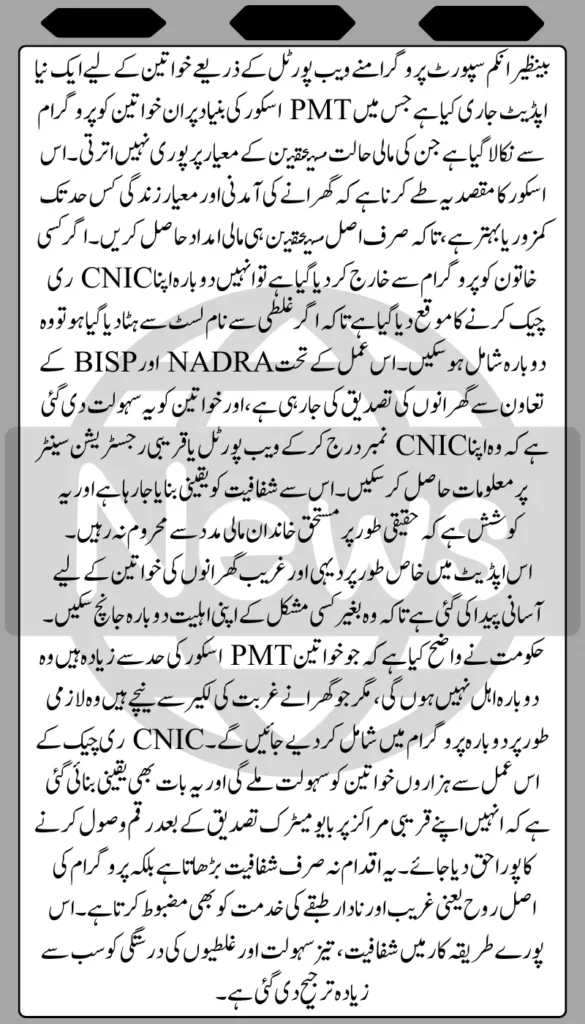Understanding the PMT Score in BISP
The PMT score Update, or Proxy Means Test score, is a system introduced by the National Socio-Economic Registry. It evaluates the financial and social conditions of families to decide whether they are eligible for assistance under BISP. The PMT score is not random but based on several factors such as family size, household income, type of housing, and ownership of basic assets.

In 2025, the eligibility threshold was revised, and only families with a PMT score of 32 or below can receive financial assistance. This change has been the main reason why many women were removed from the beneficiary list. Even small improvements in household conditions, such as ownership of a motorcycle or slight increases in income, can raise the PMT score above the threshold. While the purpose is to target the poorest families, the system has sometimes penalized households that are still struggling to survive.
You can also read: Maryam Nawaz Announces Rs 1 Million Support to Flood Affected Families
Why Women Are Being Removed in 2025
The removal of women from BISP is linked to multiple factors. In some cases, the removal is justified, such as when a household’s income has genuinely improved, or new assets have been added. However, in many situations, women are removed because of outdated records, errors in the NSER survey, or incomplete information in the NADRA database.
Widows, single mothers, and housewives are among the most affected groups. Many of them do not own large assets, yet they have been declared ineligible because of small property, livestock, or errors during data collection. The revised government policy of 2025 has further restricted aid to only the poorest families, which means borderline cases are now excluded even though their economic condition has not improved significantly.
Impact of Removal on Poor Families
The sudden removal from BISP has had a devastating effect on many families. For women, particularly widows and single mothers, the cash stipend was often the only reliable source of income. Losing this support means they struggle to pay for food, school fees, medicines, and daily needs. Families that already lived in poverty now face deeper insecurity.
Some women have been forced to take loans from relatives or moneylenders, increasing their financial burden. Others have withdrawn children from schools because they cannot afford fees or supplies. Emotional stress is also common, as women feel helpless without any means to sustain their households. This shows how dependent poor families are on BISP, and why a fair and accurate eligibility system is so critical.
How to Check CNIC Status Through 8171
BISP has made it simple for beneficiaries to check their CNIC status before starting the re-application process. Women can send their CNIC number through SMS to 8171, or they can visit the official portal at 8171.bisp.gov.pk. Both options provide clear information about whether their names are still on the beneficiary list or if they were removed due to a high PMT score.
The portal requires entering the CNIC and completing a captcha verification. Once submitted, the system shows whether a person is eligible, ineligible, or under review. This first step is essential because it informs women about the exact reason for their removal, which helps them decide what corrective actions are required.
You can also read: CM Punjab Ration Card Scheme 2025 – Monthly Relief of Rs. 3000
Fixing Eligibility Through a Re-Survey
If the CNIC check shows removal due to a high PMT score, women can request a re-survey. This process allows households to update their information with BISP and correct any errors that may have caused their ineligibility. The re-survey is conducted at the BISP Tehsil offices, where women must personally visit with their CNIC and other necessary documents.
During the re-survey, updated data about dependents, income, and housing conditions is collected. Women should provide accurate details and ensure that all official records match their real situation. If mistakes are identified in NADRA records, applicants should get them corrected immediately to avoid permanent disqualification. The re-survey provides an opportunity for those unfairly removed to restore their eligibility and rejoin the program.
Important Documents Required for Re-Application
To complete the re-survey smoothly, women must carry certain documents. A valid CNIC is essential, along with children’s B-Forms to verify dependents. Recent utility bills are required to confirm residence and household expenses. Widows must bring widow certificates, while applicants with disabilities should carry disability certificates.
These documents prove the actual financial condition of a family. Carrying all required paperwork reduces the chances of rejection or repeated visits to the office. In many cases, delays happen because women come without complete documents, which forces them to start the process again. Proper preparation is therefore crucial for a successful re-application.
PMT Score Removal vs Permanent Disqualification
It is important to understand that being removed due to a PMT score does not always mean permanent disqualification. If a woman’s removal is linked to errors or outdated data, her eligibility can be restored through re-survey and corrected records. For example, expired CNICs or wrong NADRA information can be fixed.
However, some cases result in permanent disqualification. If a family member is employed in government service or if fraudulent data was provided, the household cannot rejoin the program. Likewise, duplicate registrations and intentional misinformation can result in permanent exclusion. Beneficiaries should therefore always provide accurate data to avoid permanent removal.
You can also read: Check Your Ehsaas Program Benazir Payment Update 2025
Common Challenges Faced by Women During Re-Application
The re-survey and re-application process, while helpful, is not without difficulties. Tehsil offices often face long queues, and women sometimes wait for hours before their cases are processed. Data entry mistakes by staff can also cause problems, requiring multiple follow-ups. Another major issue is lack of awareness about required documents, which results in incomplete applications and wasted time.
Some women also face challenges in transportation to the Tehsil offices, especially in rural areas. These difficulties can be discouraging, but it is important for applicants to remain patient and persistent. Once the process is completed correctly, many women are able to restore their eligibility and continue receiving financial support.
Securing Eligibility in the Future
To avoid being removed again, women should take proactive steps to keep their records updated. This includes regularly updating NADRA about changes in marital status, children’s information, or addresses. All documents should remain valid, and CNICs or B-Forms should not expire.
Another important step is to avoid dealing with middlemen or agents. Some individuals claim they can reduce PMT scores in exchange for money, but these are scams that can result in permanent disqualification. Women should only rely on official BISP channels for information and services. By staying informed and keeping records accurate, they can secure their eligibility and continue receiving financial assistance.
Final Summary
The removal of women from BISP due to changes in the PMT score has created serious challenges in 2025. Thousands of families are now struggling to meet basic needs without the monthly stipend. However, the system also provides a chance for correction through CNIC re-check and re-survey. Women who believe they were unfairly removed can restore eligibility by updating their records, carrying the right documents, and following official procedures.
BISP remains one of the most important social protection programs in Pakistan. By ensuring accuracy in data and fairness in implementation, it can continue to support millions of poor families. Women beneficiaries should remain vigilant, keep their documents valid, and regularly check their CNIC status through 8171. With patience and persistence, many of them can regain access to this critical lifeline.
You can also read: Benazir Hunarmand Program 2025 Online Registration Method & Last Date
FAQs
1. What is the PMT score in BISP?
The PMT score is a Proxy Means Test used to assess the financial situation of families. In 2025, only households with a score of 32 or below are eligible for BISP assistance.
2. Why are women being removed from BISP in 2025?
Women are being removed due to higher PMT scores, errors in survey data, outdated NADRA records, or revised government policies that restrict aid to the poorest households.
3. How can I check my CNIC status in BISP?
You can send your CNIC number to 8171 via SMS or visit the official portal at 8171.bisp.gov.pk to check your eligibility status.
4. Can removal due to PMT score be corrected?
Yes, in most cases removal can be corrected by requesting a re-survey and updating NADRA records. Only permanent disqualification cases cannot be reversed.
5. What documents are required for re-application?
Applicants must carry a valid CNIC, children’s B-Forms, recent utility bills, widow certificates if applicable, and disability certificates if required.
6. What causes permanent disqualification from BISP?
Permanent disqualification happens if a family member is a government employee, if fraudulent or duplicate data is found, or if beneficiaries provide false information.
7. Where should women go for a re-survey?
Women should visit the nearest BISP Tehsil office with all required documents to request a re-survey and correction of records.
8. What problems can occur during re-application?
Common problems include long waiting times at offices, data entry mistakes by staff, incomplete documents, and multiple visits due to errors.
9. How can women secure their eligibility in the future?
Women should keep their NADRA records updated, renew CNICs and B-Forms on time, and avoid dealing with agents or middlemen.
10. Is BISP still providing support to poor families in 2025?
Yes, despite challenges, BISP continues to provide financial support to millions of families. Women who face removal can often regain eligibility through the proper process.
